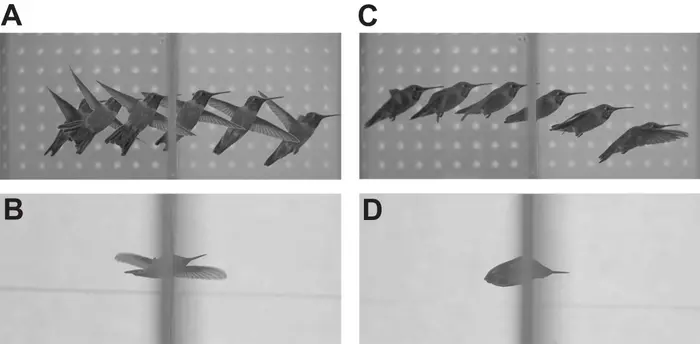Soaring, wings outstretched, many birds sail through the air unhindered. However, species that dine on fruit, seeds and nectar must negotiate tiny gaps in cluttered foliage to secure a feast.
To pass through apertures, many birds pull in their wings, folding them closer to their bodies. However, some of the most manoeuvrable aviators, hummingbirds, have lost the ability to fold their wings at the wrists and elbows. ‘Unless hummingbirds implement distinctive strategies to transit narrow apertures, they may be unable to enter gaps less than one wingspan wide’, says Marc Badger from University of California, Berkeley (UCB), USA. So how do the extraordinarily agile aeronauts, which can even fly backwards, negotiate the cluttered environments that make their homes? Teaming up with Kathryn McClain, Ashley Smiley, Jessica Ye and Robert Dudley (all from UCB), Badger set out to discover how Anna’s hummingbirds (Calypte anna) slip through tiny openings despite being unable to fold their wings in. The team publishes their discovery in Journal of Experimental Biology that they birds use two unique strategies that allow them to penetrate gaps that are barely half a wingspan wide.
‘We set up a two-sided flight arena and wondered how to train birds to fly through a 16 cm2 gap in the partition separating the two sides. Then Kathryn had the amazing idea to use alternating rewards’, says Badger, explaining that the team only refilled a flower-shaped feeder with a sip of sugar solution once the bird had returned to the feeder opposite, to encourage the ~12 cm wingspan birds to flit to and fro. Badger, Smiley and Ye then replaced the gap with a series of smaller oval and circular apertures – ranging in height, width and diameter from 12 to 6 cm – for the birds to negotiate, while they filmed the birds’ manoeuvres with high-speed cameras. Then, Badger wrote a computer program to methodically track the position of each bird’s bill as they approached and passed through each aperture, while also locating the bird’s wing tips, to calculate their wing positions as they transited through.
Impressively, the hummingbirds used two unique strategies to negotiate the gaps. In the first, they approached the aperture, often hovering in front of it to assess it first, before travelling through sideways, reaching forward with one wing while sweeping the second wing back – almost making the shape of a cross – while still fluttering their wings to fly through the aperture, then swivelling forward to continue on their way. In the second strategy, they swept their wings back, pinning them to their bodies, and shot through beak first like a bullet, before sweeping the wings forward and resuming flapping again once safely through.
Scrutinising the two strategies, the team realised that the birds that were travelling sideways tended to fly more cautiously and slowly than the birds that shot through the apertures beak first. And, as the birds became more familiar with the apertures after several approaches, they appeared to become more confident, approaching swiftly and dropping the more cautious sideways approach in favour of darting through beak first. However, the smallest aperture – half a wingspan wide – always presented the most difficulty, with every bird zipping through facing forward with their wings pinned back – even on the first attempt – to avoid collisions.
So, hummingbirds have developed strategies that allow them to penetrate tiny gaps less than a wingspan wide, with the sideways option enabling them to take a more cautious approach, transitioning to shooting through beak first as they become bolder. And the team points out that although ~8% of the birds clipped their wings as they passed through the partition, only one experienced a major collision, and even then, the bird recovered quickly before successfully reattempting the manoeuvre and going on its way.


